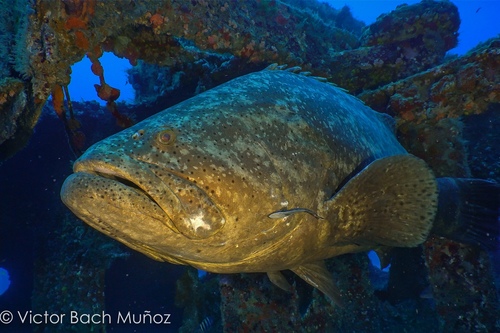
Atlantic Goliath Grouper
The Atlantic bluefin tuna (Thunnus thynnus) is a magnificent, highly migratory species renowned for its size, speed, and commercial value. As one of the largest bony fish, it plays a crucial role in the marine ecosystem. It is a top predator and has unique physiological adaptations.
15 37 years
Lifespan
250 cm
Length
Vulnerable
Conservation Status
Carnivorous, Scavengers
Diet
Local Migration
Migration
Appearance Overview
The Atlantic bluefin tuna is a large, torpedo-shaped fish with a metallic blue-black back and a silver-white belly.
Coloration
Dark metallic blue on top, silvery-white underside
Body Shape
Torpedo-shaped, streamlined for speed
Fins
Two dorsal fins, the first depressible; small finlets run from dorsal and anal fins to tail
Keel
Strong lateral keel on the caudal peduncle
Length
Up to 13 feet (4 meters)
Weight
Up to 2,000 lbs (907 kg)
Diet
Carnivorous, feeding on smaller fish (like herring, mackerel, and hake), squid, eels, and crustaceans.
Feeding Behavior
Highly active predator, uses speed and agility to hunt. They are ram ventilators, meaning they must constantly swim to breathe. They often hunt cooperatively, corralling prey.
Social Behavior
Forms large schools, especially when young. Schools may be segregated by size. Highly migratory, capable of long-distance travel across oceans, exhibiting complex migration patterns linked to spawning and feeding grounds.
Commercial Relevance
Extremely high value, particularly in the sushi and sashimi markets of Japan. Individual fish can sell for hundreds of thousands, or even millions, of dollars at auction. Also important for recreational fishing industries in some regions, though subject to strict regulations due to overfishing concerns.
Conservation measures
International fishing quotas and regulations managed by organizations like ICCAT (International Commission for the Conservation of Atlantic Tunas). Minimum size limits, seasonal closures, and gear restrictions are in place in many areas. Research and monitoring efforts are ongoing to improve stock assessments and management strategies.
Status
Endangered (IUCN). Some populations are considered critically endangered.
Threats
Historical overfishing is the primary threat, significantly depleting populations. Continued fishing pressure, both legal and illegal, remains a major concern. Bycatch in fisheries targeting other species also poses a threat. Climate change may impact their distribution and prey availability.
Habitat Distribution
Depth Range
0-1,000 meters (typically 0-200 meters)
Geographic Range
North Atlantic Ocean, Mediterranean Sea, and formerly the Black Sea.
Preferred Environment
Pelagic, open ocean waters; also found in coastal areas during certain times of the year for spawning and feeding. They prefer temperate waters but can tolerate a wide range of temperatures due to their endothermy.
Reproduction and Life Cycle
Breeding Habits
Spawns in warm waters, primarily in the Mediterranean Sea and the Gulf of Mexico. Spawning occurs in specific areas and seasons, with females releasing millions of eggs into the water column.
Development Stages
Eggs hatch into larvae, which are planktonic and drift with the currents. Juveniles grow rapidly, forming schools and gradually moving to different feeding grounds. They undergo significant physiological changes as they mature.
Fecundity
Highly fecund; a single female can produce up to 30 million eggs per spawning season, although survival rates of eggs and larvae are low.
Maturity Age
Matures at 4-8 years in the Mediterranean and at around 9-13 years in the western Atlantic, though this can vary depending on environmental conditions and population status. This difference in maturation age is a key factor in managing the different stocks.
Faqs about Atlantic Goliath Grouper
Where can you find Atlantic bluefin tuna?
Atlantic bluefin tuna are found in the Atlantic Ocean, including the Mediterranean Sea. They are highly migratory, with some populations crossing the entire ocean.
How long do Atlantic bluefin tuna live?
Atlantic bluefin tuna can live up to 40 years, although this is becoming increasingly rare due to fishing pressure.
How fast can Atlantic bluefin tuna swim?
They are among the fastest fish in the ocean, capable of bursts of speed up to 43 mph (70 km/h).
Is Atlantic bluefin tuna really that valuable?
Yes, the high demand, especially in Japan, has driven prices to extremely high levels, making it one of the most expensive fish in the world.
Are Atlantic bluefin tuna endangered?
Yes, due to severe population declines, Atlantic bluefin tuna are listed as Endangered by the IUCN.
What do Atlantic bluefin tuna eat?
They primarily feed on smaller fish, squid, and crustaceans. Their diet varies depending on their size and location.
How big do Atlantic bluefin tuna get?
They can reach lengths of up to 13 feet (4 meters) and weights of up to 2,000 lbs (907 kg), though individuals this large are now rare.
Who manages Atlantic bluefin tuna fishing?
ICCAT is the primary organization responsible for managing Atlantic bluefin tuna fisheries, setting quotas and regulations.
Are Atlantic Bluefin Tuna warm-blooded?
Atlantic bluefin tuna are warm-blooded, unlike most fish, which helps them maintain high activity levels in cold waters.
Copyright @ Nature Style Limited. All Rights Reserved.
 English
English